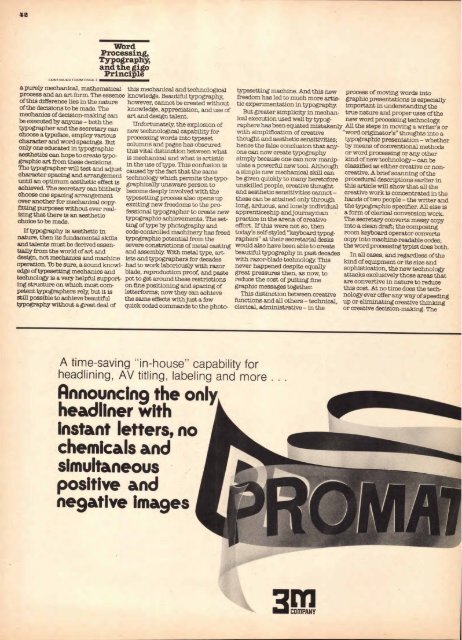Volume 2–3.pdf
Volume 2–3.pdf
Volume 2–3.pdf
Create successful ePaper yourself
Turn your PDF publications into a flip-book with our unique Google optimized e-Paper software.
42<br />
■INIINI■111Mi■I<br />
Word<br />
Processing,<br />
Typography,<br />
and the gigo<br />
Principle<br />
CONTINUED FROM PAGE 3 =II■1I■1<br />
a purely mechanical, mathematical this mechanical and technological<br />
process and an art form. The essence knowledge. Beautiful typography<br />
of this difference lies in the nature however, cannot e created without<br />
of the decisions to be made. The knowledge, appreciation, and use of<br />
mechanics of decision-making can art and design talent.<br />
be executed by anyone - both the<br />
Unfortunately, the explosion of<br />
typographer and the secretary can<br />
new technological capability for<br />
choose a typeface, employ various<br />
processing words into typeset<br />
character and word spacings. But<br />
columns and pages has obscured<br />
only one educated in typographic<br />
this vital distinction between what<br />
aesthetics can hope to create typo-<br />
is mechanical and what is artistic<br />
graphic art from these decisions.<br />
in the use of type. This confusion is<br />
The typographer will test and adjust caused by the fact that the same<br />
character spacing and arrangement technology which permits the typountil<br />
an optimum aesthetic effect is graphically unaware person to<br />
achieved. The secretary can blithely become deeply involved with the<br />
choose one spacing arrangement typesetting process also opens up<br />
over another for mechanical copy- exciting new freedoms to the profitting<br />
purposes without ever real- fessional typographer to create new<br />
izing that there is an aesthetic<br />
choice to be made.<br />
typographic achievements. The setting<br />
of type by photography and<br />
If typography is aesthetic in code-controlled machinery has freed<br />
nature, then its fundamental skills typographic potential from the<br />
and talents must be derived essen- severe constrictions of metal casting<br />
tially from the world of art and and assembly. With metal type, artdesign,<br />
not mechanics and machine ists and typographers for decades<br />
operation. To be sure, a sound knowl- had to work laboriously with razor<br />
edge of typesetting mechanics and blade, reproduction proof, and paste<br />
technology is a very helpful support- pot to get around these restrictions<br />
ing structure on which most com- on fine positioning and spacing of<br />
petent typographers rely, but it is letterforms; now they can achieve<br />
still possible to achieve beautiful the same effects with just a few<br />
typography without a great deal of quick coded commands to the photo-<br />
A time-saving "in-house" capability for<br />
headlining, AV titling, labeling and more . .<br />
Announcing the only<br />
headliner with<br />
instant letters, no<br />
chemicals and<br />
simultaneous<br />
positive and<br />
negative Images<br />
typesetting machine. And this new process of moving words into<br />
freedom has led to much more artis- graphic presentations is especially<br />
tic experimentation in typography important in understanding the<br />
But greater simplicity in mechan- true nature and proper uses of the<br />
ical execution used well by typog- new word processing technology<br />
raphers has been equated mistakenly All the steps in moving a writer's or<br />
with simplification of creative "word originator's" thoughts into a<br />
thought and aesthetic sensitivities; typographic presentation - whether<br />
hence the false conclusion that any- by means of conventional methods<br />
one can now create typography or word processing or any other<br />
simply because one can now manip- kind of new technology- can be<br />
ulate a powerful new tool. Although<br />
a simple new mechanical skill can<br />
be given quickly to many heretofore<br />
unskilled people, creative thought<br />
and aesthetic sensitivities cannot -<br />
these can be attained only through<br />
long, arduous, and lonely individual<br />
apprenticeship and journeyman<br />
practice in the arena of creative<br />
effort. If this were not so, then<br />
today's self-styled "keyboard typographers"<br />
at their secretarial desks<br />
would also have been able to create<br />
beautiful typography in past decades<br />
with razor-blade technology. This<br />
never happened despite equally<br />
great pressures then, as now, to<br />
reduce the cost of putting fine<br />
graphic messages together.<br />
This distinction between creative<br />
functions and all others - technical,<br />
clerical, administrative - in the<br />
classified as either creative or noncreative.<br />
A brief scanning of the<br />
procedural descriptions earlier in<br />
this article will show that all the<br />
creative work is concentrated in the<br />
hands of two people - the writer and<br />
the typographic specifier. All else is<br />
a form of clerical conversion work.<br />
The secretary converts messy copy<br />
into a clean draft; the composing<br />
room keyboard operator converts<br />
copy into machine-readable codes;<br />
the word processing typist does both.<br />
In all cases, and regardless of the<br />
kind of equipment or its size and<br />
sophistication, the new technology<br />
attacks exclusively those areas that<br />
are convertive in nature to reduce<br />
this cost. At no time does the technology<br />
ever offer any way of speeding<br />
up or eliminating creative thinking<br />
or creative decision-making. The
















